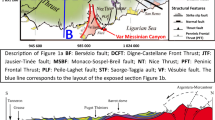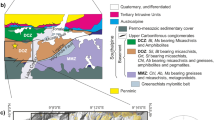Abstract
The eastern side of the Mt. Amiata volcano is affected by a series of deep-seated gravitational slope deformations (DsGSDs). The San Piero and the Podere Mezzavia DsGSDs affect the lower part of the slope. The main escarpments are located on the outer edges of the lava flows, but the landslides mostly affect the pre-volcanic Ligurian Terrains. A deeper movement, possibly exceeding 100 m in thickness, is evidenced by a long trench at the base of the main escarpment that indicates a sagging type movement. This deeper movement is responsible for the activation of a series of superficial rock and mud flows that show evidence of ongoing activity. The most likely location of the sliding surface is the tectonized contact between the Santa Fiora and Argille a Palombini Fms within the Ligurian units, although the superficial landslides prevent our determining with certainty if a clear-cut sliding surface already developed connecting the upper and the lower parts of the slope. These DsGSDs were activated along the flanks of a larger movement that affects the lava flow units cropping out in the middle slope of the volcano. A long main escarpment, secondary escarpments, trenches and borehole data suggest that the thickness could locally exceed 200 m and generate another sagging type movement. Up-slope and up-movement-facing counterscarps indicate the existence of a listric elongated spoon-shaped compound embryonic sliding surface. This sagging, which hosts the towns of Abbadia San Salvatore and Piancastagnaio, appears to be in a quiescent stage, according to preliminary monitoring with a global positioning system (GPS) network. The downcutting of the river network along the softer Pliocene terrains of the Radicofani basin is enhanced by the general uplift of the Apennines and seems to be the major factor in the activation of these DsGSDs.








Similar content being viewed by others
References
Ablay G, Hurlimann M (2000) Evolution of the north flank of Tenerife by recurrent giant landslides. J Volcanol Geotherm Res 103:135–159
Acocella V (2000) Space accomodation by roof lifting during pluton emplacement at Amiata Mt. (Italy). Terra Nova 12:149–155
Agliardi F, Crosta G, Zanchi A (2001) Structural constraints on deep-seated slope deformation kinematics. Eng Geol 59:8–102
Agnesi V, Malacuso T, Monteleone S, Pipitone G (1984) Fenomeni di deformazione gravitativa profonda (deep-seated slope deformations) osservati nella Sicilia occidentale. Boll Soc Geol It 103:671–679
Batini F, Brogi A, Lazzarotto A, Liotta D, Pandeli E (2003) Geological features of Larderello–Travale and Mt.Amiata geothermal areas (southern Tuscany, Italy). Episodes 26(3):239–244
Bentivenga M, Coltorti M, Prosser G (2004) Il movimento gravitativo profondo di Craco (Basilicata Ionica). Il Quat 17(2/2):613–625
Boscato P, Coltorti M, Reggiani P (2008) Pliocene Anancus arvernensis (Croizet & Jobert, 1828) remains from Cetona (Siena): stratigraphy, chronology and paleoenvironment. Boll Soc Geol It 127(1):151–162
Brogi A (2004) Miocene low-angle normal detachments and upper crust megaboudinage in the Mt Amiata geothermal area (Northern Apennines Italy). Geodinamica Acta 17:375–387
Brogi A (2007) The structure of the Mt. Amiata volcano-geothermal area (Northern Apennines, Italy): Neogene-Quaternary compression versus extension. Int J Earth Sci. doi:10.1007/s00531-007-0191-1
Brogi A, Liotta D (2006) Understanding the crustal structures of southern Tuscany: the contribution of the CROP18 project. Bollettino di Geofisica Teorica ed Applicata 47:401–423
Calamai A, Cataldi R, Squarci P, Taffi L (1970) Geology, Geophysics and Hydrogeology of the Monte Amiata Geothermal Field. Geothermics 1(Spec):1–9
Carmignani L, Decandia FA, Disperati L, Fantozzi PL, Lazzarotto A, Liotta D, Meccheri M (1994) Tertiary extensional tectonics in Tuscany (Northern Apenines, Italy). Tectonophysics 238:295–315
Cavallin A, Crescenti U, Dramis F, Prestininzi A, Sorriso-Valvo M (1987) Tipologia e diffusione delle deformazioni gravitative profonde di versante in Italia: prime valutazioni. Mem Soc Geol It 37:241–252
Coltorti M, Dramis F (1995) The chronology of Upper Pleistocene stratified slope-waste deposits in Central Italy. Permafr Periglac Process 6:235–242 (Chichester)
Coltorti M, Pieruccini P (2002) The late Lower Pliocene Planation surface and mountain building of the Apennines (Italy). In: Dramis F, Farabollini P, Molin P (eds) Large-scale vertical movements and related processes. Studi Geol Camerti NS 1:45–60
Coltorti M, Dramis F, Gentili B, Pambianchi G, Crescenti U, Sorriso-Valvo M (1984) The December 1982 Ancona landslide: a case of deep-seated gravitational slope deformation evolving at unsteady rate. Z Geomorph NF 29(3):335–345
Coltorti M, Ravani S, Verrazzani F (2007) Progressive unconformities, depositional sequence and the growth of the Monti del Chianti Ridge: evidence from the Santa Barbara Basin (Upper Valdarno, Italy). Il Quat 20(1–2):67–84
Coltorti M, Ravani S, Cornamusini G, Ielpi A, Verrazzani F (2009) The embryonic stage in deep-seated slope deformations: the case of the eastern side of the Chianti Mts. (Northern Apennines, Italy). Geomorphology 112:15–26
Crowley JK, Zimbelman DR (1997) Mapping hydrothermally altered rocks on Mount Rainier, Washington, with Airborne Visible/Infra-red Imaging Spectrometer (AVIRIS) data. Geology 25:559–562
Day SJ, Carracedo JC, Guillou H (1997) Age and geometry of an aborted rift flank collapse: the San Andres fault system, El Hierro, Canary Islands. Geol Mag 134(4):523–537
Dikau R, Brunsden D, Schrott L, Ibsen ML et al (eds) (1996) Landslide Recognition. Identification, Movement and Causes. J. Wiley & Sons, Chichester, 251 pp
Disperati L, Liotta D (1998) Estimating uplift of clay-filled extensional basins through the porosity-depth curve: the case of the Radicofani Basin (Italy). Ann Tectonicae XII(1–2):162–176
Dramis F, Sorriso-Valvo M (1994) Deep-seated gravitational slope deformations, related landslides, and tectonics. Eng Geol 38(3–4):231–243
Eckl MC, Snay RA, Soler T, Cline MW, Mader GL (2001) Accuracy of GPS-derived relative positions as a function of interstation distance and observing-session duration. J Geod 75:633–640
Elsworth D, Voight B (1995) Dike intrusion as a trigger for large earthquakes and the failure of volcano flanks. J Geophys Res 100(B4):6005–6024
Elter FM, Pandeli E (1991) Structural features of the metamorphic Paleozoic-Triassic sequences in deep geothermal drillings of the Mt. Amiata area (SE Tuscany, Italy). Boll Soc Geol It 110:511–522
Ferrari L, Conticelli S, Burlamacchi L, Manetti P (1996) Volcanological evolution of the Monte Amiata, Southern Tuscany: new geological and petrochemical data. Acta Vulcanol 8:41–56
Firuzabadì F, King RW (2011) GPS precision as a function of session duration and reference frame using multi-point software. GPS Solutions. doi:10.1007/s10291-011-0218-8
Gianelli G, Puxeddu M, Batini F, Bertini G, Dini I, Pandeli E, Nicolich R (1988) Geological model of a young volcano-plutonic system: the geothermal region of Monte Amiata (Tuscany, Italy). Geothermics 17:719–734
Hofmann-Wellenhof B, Lichtenegger H, Collins J (1997) GPS theory and practice. Springer, New York
Holcomb RT, Searle RC (1991) Large landslides from oceanic volcanoes. Mar Geotechnol 10:19–32
Hurlimann M, Ledesma A, Martì J (1999) Conditions favoring catastrophic landslides on volcanoes. Terra Nova 11:106–111
Hurlimann M, Garcia J, Ledesma A (2000) Causes and mobility of large volcanic landslides: application to the north flank of Tenerife, Canary Islands. J Volcanol Geotherm Res 103:121–134
Hutchinson JN (1988) General report: morphological and geotechnical parameters of landslides in relation to geology and hydrogeology. In: Bonnard C (ed) Proceedings, 5th International Symposium of Landslides 1, Balkema, Lausanne, Switzerland, pp 3–35
Ishihara K, Hsu H-L (1986) Landslides in natural slopes during earthquakes. Proc. Int. Symp. “Engineering Problems in Seismic Areas”, Bari, Italy, vol 5, pp 273–298
Iverson RM (1997) The physics of debris flows. Rev Geophys 35:245–296
Labazuy P (1996) Recurrent landslides events on the submarine flank of Piton de la Fournaise volcano (Reunion Island). In: McGuire WJ, Jones AP, Neuberg J (eds) Volcano instability on the earth and other planets. Geological Society. Special Publication, London, pp 295–306
Lavecchia G, Boncio P, Creati N, Brozzetti F (2004) Stile strutturale, stato termo-meccanico e significato sismogenetico del thrust Adriatico: dati e spunti da una revisione del profilo CROP 03 integrata con l’analisi di dati sismologici. Boll Soc Geol It 123:111–125
Liotta D (1996) Analisi del settore centro-meridionale del bacino pliocenico di Radicofani (Toscana meridionale). Boll Soc Geol It 115:115–143
Liotta D, Salvatorini G (1994) Evoluzione sedimentaria e tettonica della parte centro-meridionale del bacino pliocenico di Radicofani. Studi Geologici Camerti Vol Spec 1:65–77
Liotta D, Cernobori L, Nicolich R (1998) Restricted rifting and its coexistence with compressional structures: results from the Crop03 traverse (Northern Apennines Italy). Terra Nova 10:16–20
Lipman PW, Normark WR, Moore JG, Wilson JB, Gutmacher CE (1988) The giant submarine Alika debris slide, Mauna Loa, Hawaii. J Geophys Res 93(B5):4279–4299
Martì J, Hurlimann M, Ablay GJ, Gudmundsson A (1997) Vertical and lateral collapses on Tenerife (Canary Islands) and other volcanic ocean islands. Geology 25:879–882
Masson DG (1996) Catastrophic collapse of the volcanic island of Hierro 15 ka ago and the history of landslides in the Canary Islands. Geology 24(3):231–234
Moore JG, Clague DA, Holcomb RT, Lipman PW, Normark WR, Torresan ME (1989) Prodigious submarine landslides on the Hawaiian Ridge. J Geophys Res 94:17465–17484
Moore JG, Normark WR, Holcomb RT (1994) Giant Hawaiian landslides. Ann. Rev Earth Planet 22:119–144
Nemčok A, Pasek J, Rybar J (1972) Classification of landslides and other mass movement. Rock Mech 4:71–78
Pauselli C, Barchi MR, Federico C, Magnani MB, Minelli G (2006) The crustal structure of the Northern Apennines (Central Italy): an insight by the CROP03 seismic line. Am J Sci 306:428–450
Sestini A (1981) Un’antica superficie d’erosione nei Monti del Chianti. Riv Geogr Ital 88:214–220
Urgeles R, Masson DG, Canals M, Watts T, Le Bas T (1999) Recurrent large-scale landsliding on the west flank of La Palma, Canary Islands. J Geophys Res 104(B11):25331–25348
Varnes DJ (1978) Slope movements types and processes. In: Schuster RL, Krizek RJ (eds) Landslides, analysis and control, transp. Res. board, Spec. Rep., vol 176. Nat Acad Sci, Washington, DC, pp 11–33
Voight B, Janda RJ, Glicken H, Douglass PM (1983) Nature and mechanics of the Mount St Helens rockslide-avalanche of 18 May 1980. Geotechnique 33:243–273
Watts AB, Masson DG (1995) A giant landslide on the north flank of Tenerife, Canary Islands. J Geophys Res 100:24487–24498
Zischinsky U (1969) Uber sackungen. Rock Mech 1(1):30–52
Acknowledgments
Special thanks to the Assessorato all’Ambiente of the Siena Province for having granted the geomorphological mapping that firstly led to the recognition of the DsGSD in the Mt Amiata area and, more recently, for having stimulated the continuation of the investigation. Many thanks also to the Comunità Montana del Monte Amiata, and particularly to Dr. D. Rappuoli for useful discussions and information regarding the depth of the bedrock in the Abbadia San Salvatore area.
Author information
Authors and Affiliations
Corresponding author
Rights and permissions
About this article
Cite this article
Coltorti, M., Brogi, A., Fabbrini, L. et al. The sagging deep-seated gravitational movements on the eastern side of Mt. Amiata (Tuscany, Italy). Nat Hazards 59, 191–208 (2011). https://doi.org/10.1007/s11069-011-9746-3
Received:
Accepted:
Published:
Issue Date:
DOI: https://doi.org/10.1007/s11069-011-9746-3




